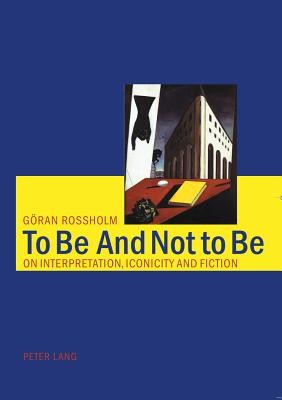
- We will send in 10–14 business days.
- Author: Göran Rossholm
- Publisher: Peter Lang Publishing
- ISBN-10: 3039100475
- ISBN-13: 9783039100477
- Format: 14.8 x 21 x 2 cm, minkšti viršeliai
- Language: English
- SAVE -10% with code: EXTRA
To Be And Not to Be; On Interpretation, Iconicity and Fiction (e-book) (used book) | bookbook.eu
Reviews
Description
To Be And Not to Be is a study of the interrelated concepts interpretation, iconicity and fiction as applied to works of art in general and literary narratives in particular. Two perspectives run through the book: a semiotic one, focusing on the work of art and what it stands for - represents, expresses, alludes to, etc. - and a psychological one, focusing on the audience's interpretation of the work.The book establishes an ongoing dialogue with recent research within analytic aesthetics, narratology and other relevant fields. In particular, the philosopher Nelson Goodman's theory of symbols has proved to be fruitful in the development of new and original concept formations with respect to interpretation, iconicity and fictionality.
In the first part some fundamental questions of literary theory are focused on, foremost what is meant by intentional interpretation, the relation between literary interpretation and understanding of everyday spontaneous discourse as analyzed by Paul Grice, and how to locate aesthetic interpretation within the wider scope of interpretive practices. These discussions yield some conceptual tools deployed in the two following parts of the book. The second part opens with a suggestion on the concept of pictorial representation. This is generalized to apply to verbal and literary phenomena such as temporal matching, quotation, and uses of point of view in narratives. In the final part recent philosophical accounts of fictionality are discussed.
EXTRA 10 % discount with code: EXTRA
The promotion ends in 22d.03:56:08
The discount code is valid when purchasing from 10 €. Discounts do not stack.
- Author: Göran Rossholm
- Publisher: Peter Lang Publishing
- ISBN-10: 3039100475
- ISBN-13: 9783039100477
- Format: 14.8 x 21 x 2 cm, minkšti viršeliai
- Language: English English
The book establishes an ongoing dialogue with recent research within analytic aesthetics, narratology and other relevant fields. In particular, the philosopher Nelson Goodman's theory of symbols has proved to be fruitful in the development of new and original concept formations with respect to interpretation, iconicity and fictionality.
In the first part some fundamental questions of literary theory are focused on, foremost what is meant by intentional interpretation, the relation between literary interpretation and understanding of everyday spontaneous discourse as analyzed by Paul Grice, and how to locate aesthetic interpretation within the wider scope of interpretive practices. These discussions yield some conceptual tools deployed in the two following parts of the book. The second part opens with a suggestion on the concept of pictorial representation. This is generalized to apply to verbal and literary phenomena such as temporal matching, quotation, and uses of point of view in narratives. In the final part recent philosophical accounts of fictionality are discussed.


Reviews